

It is a requirement of the medical industry to manufacture durable and reliable medical-grade components that meet compliance and FDA standards. One of the top manufacturing processes that yields precision, accuracy, and quality is the medical injection molding process.
Medical injection molding is an efficient and cost-effective process for manufacturing medical parts. It is also today, sometimes the go-to process for manufacturing any state-of-the-art medical equipment as this process can incorporate complex designs. Medical injection molding also serves as the medical prototype development approval process for the FDA. It offers various benefits and is popularly used to create plastic parts for the medical, healthcare, and pharmaceutical industries. The range encompasses medical devices, laboratory tools, surgical equipment, and testing instruments. In this article, we explain what the medical injection molding process entails and its role in the medical industry.
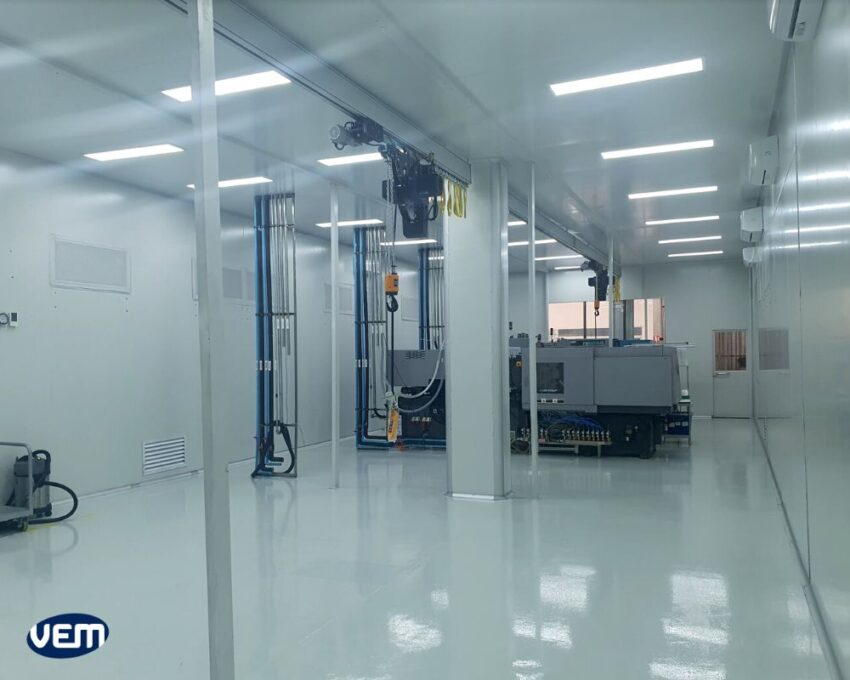
The process of Medical injection molding is similar to the other industries. An optimized operation yields a smooth and seamless production. Let’s take a look at some of the benefits:
Injection molding offers an extensive range of plastics to choose from. Although not all plastics can be used for medical injection molding, there are still various types of medical-grade plastics to choose from, for manufacturing medical components.
Medical products need to be in accordance with FDA regulations, which recognize ISO standards. Medical injection molding is a controlled process, which makes it easier to meet ISO compliance. Examples include tight controls on materials and measures taken to prevent contamination. In maximum instances, the manufacturing facility is controlled to regulate specific temperature levels. Every specific parameter during the production is documented and this sets the standard for repeatability.
You should note that in order to meet the minimum requirements of medical manufacturing standards, the manufacturer must be ISO 13485 certified. The following images demonstrate certain compliance requirements followed to adhere to the regulations in order to meet the compliance requirements:
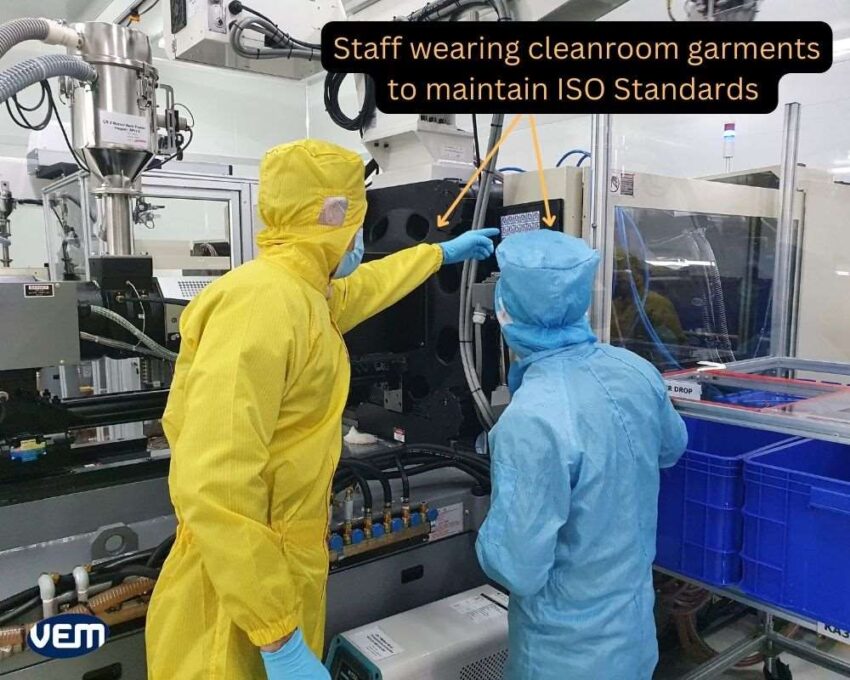
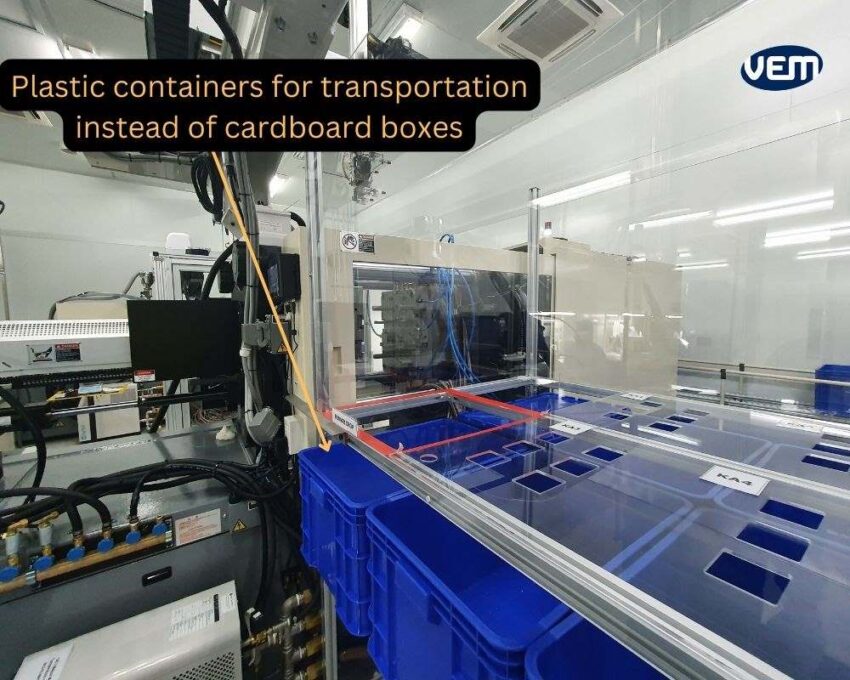
Medical plastic injection molding is an extremely cost-efficient manufacturing process. It can produce a high volume of plastic parts at extremely competitive pricing. Thus, if there is a requirement for an enormous volume of medical parts, then the cost per part can be reduced extensively through injection molding processes. This aspect benefits the manufacturers by cutting down on production costs.
Plastics that are used in the medical field possess unique mechanical properties. These plastics are designed and engineered to not only improve the performance of medical parts but also reduce their weight. This is especially the case with medical devices and it is a critical aspect, as it diminishes the fatigue that surgeons generally experience while performing long procedures. This aspect also enables patients with wearable medical devices. Lightweight medical plastic parts also benefit EMTs (emergency medical technicians), who have to carry them to attend to patients in emergencies.
Skilled injection molding facilities exhibit tight tolerances over their processes to deliver exceptional accuracy which is very much a requirement of the medical and healthcare industry. Experienced injection molders understand that any deviation from the process can not only alter molding development but can also influence the assembly and application of a product.
Plastics used in the injection molding process can withstand contaminants and various sterilization processes thus, the material usually meets FDA standards and other requirements from the governing bodies.
Plastic injection molding is a proven manufacturing process that supports high-volume production at low costs/part and design complexity while maintaining the integrity of the parts. However, there may be instances where medical parts don’t contain plastic at all; thus, they can not be manufactured through injection molding. In such cases, CNC machining can be used. Let’s take a look at some examples:
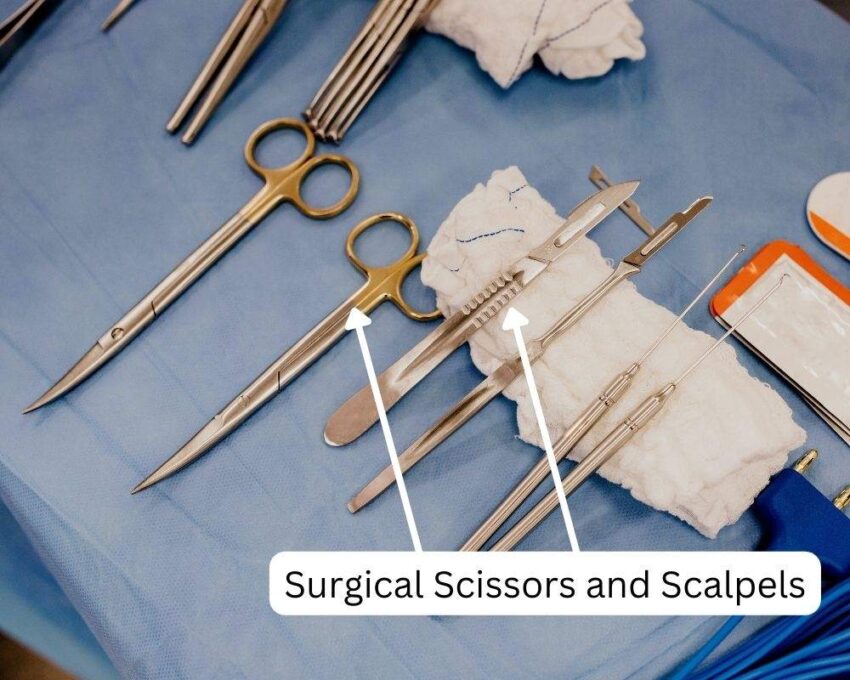
Is medical injection molding the aptest process for your application? We have devised a table to help you make the right decision! The following table illustrates Plastic Injection Molding Vs Other Processes for the medical industry.
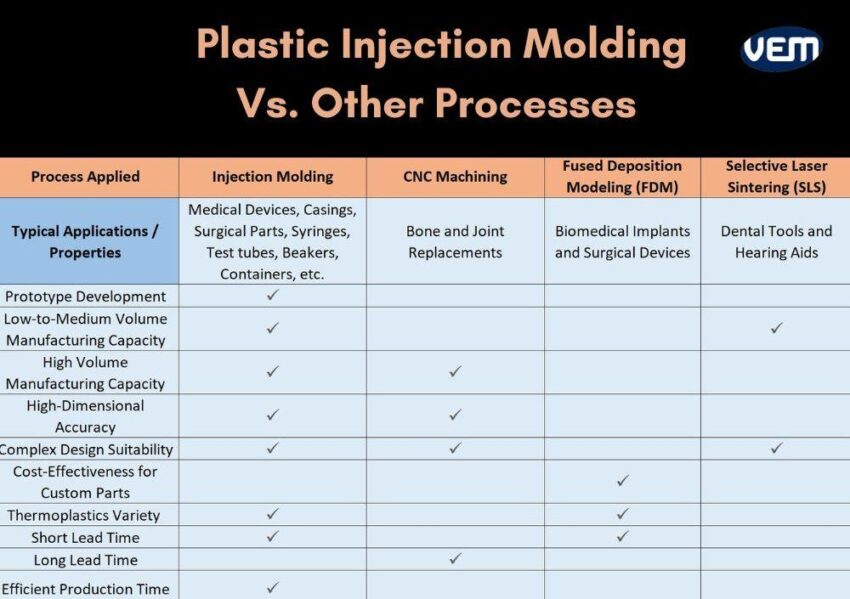
The plastic material range that is used to manufacture medical parts is quite extensive and thus, it is critical to select the most suitable material for your medical parts. The materials that are used to make medical parts depend upon how the products will be used. They should be chosen based on the following factors:
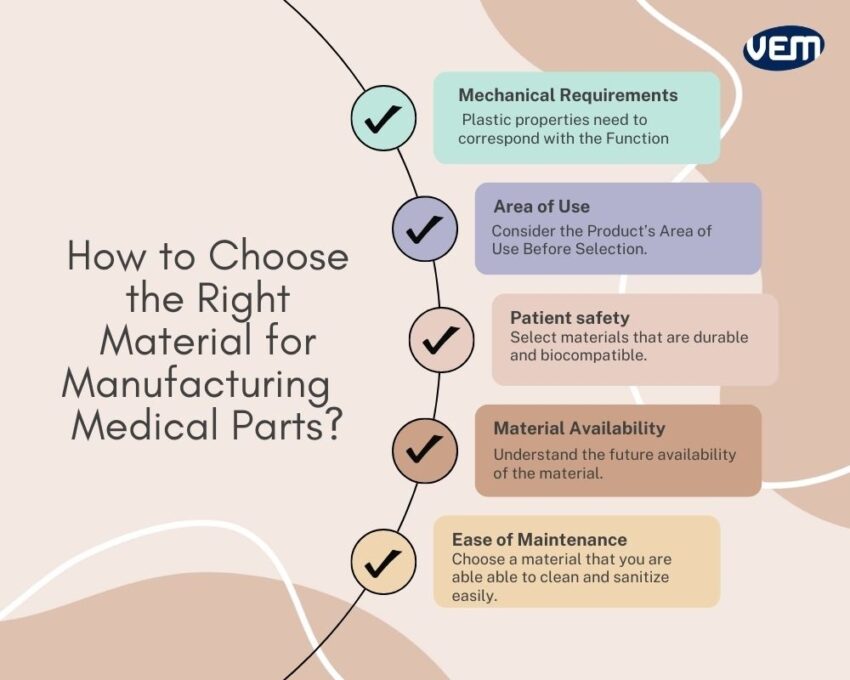
The first factor is to determine what the mechanical requirements are. Some medical parts may be exposed to extreme heat, while various others may be used in either cold or freezing environments. Another case scenario is that some medical parts may need to be soft and flexible whereas others may need to be strong and rigid. Thus, the mechanical properties of the plastic need to correspond with the function. For Instance: If you need the medical part to be UV-light resistant, and exhibit an excellent light transmission property, then PMMA may be the right material choice but if you need your medical part to be flexible, then you should choose Silicon.
You should also consider the product’s area of use before selection. For instance, single-use materials like syringes, needles, tubing, and connectors should be transparent, flexible, and easy to sterilize whereas surgical injection parts should be lightweight and ergonomic.
Patient Safety is the most important factor to consider when choosing a material for the medical parts. Manufacturers should select materials that are not just durable but also those that the body’s immune system won’t reject.
It’s important to check the safety of materials for medical parts. Whether they’re used internally or externally, these products should still be made of high-quality materials that are biocompatible. Some examples are PVC, titanium, and surgical steel.
Some materials are difficult to source because they are either expensive, or they may need to be imported. Thus, it is essential to understand the future availability of the material.
It’s imperative to use a material that will be available throughout the product’s life cycle. If the material is not easily available, manufacturers would have to use another material, which means they will need to adjust the manufacturing process. They will also need to undertake another approval with the FDA.
If you are choosing a material for manufacturing medical parts, you should be easily able to clean and sanitize the parts. This is especially the case for non-disposable medical products that may be reused in hospitals.
Materials that are chosen for medical part manufacturing must be able to withstand various sterilization processes such as autoclaving, gamma sterilization, and other methods that are used to remove contaminants. All parts that come in contact with the human body must be contaminant-resistant.
You should note that if there are electrical components, they cannot be sterilized through heating. They should then have surfaces that are made of materials such as liquid silicone rubber that can withstand chlorine and industrial-strength antimicrobial cleaning agents.
The material you choose should be durable such that it is not prone to breakage. There should be minimal to no scope for biohazards in the medical field. Thus, you should select materials that have a satisfactory durability index. They should also be able to exhibit a high level of tensile strength.
The plastic molding materials you choose should have the ability to withstand adverse conditions. They must be durable when subjected to various conditions such as extreme temperatures, corrosives, chemicals, vibrations, and other human body movements.
Today, a wide range of biocompatible plastics are available that deliver high efficiency. Plastics are a popular injection molding material due to their malleability. Some of the medical-grade plastic injection molding materials are listed below:
Polypropylene is a medical-grade polymer plastic. It contains strong chemical bonds and is resistant to stress, cracking, impact, and fatigue. Since it has a high melting point of about 1710℃ / 3110℉, it’s resistant to sterilization in the autoclave.
It’s ideal for manufacturing medical devices such as beakers and test tubes. It’s also used to make medical plastic components such as disposable syringes, oxygenator membranes, prescription bottles, and finger-joint prostheses.
Polyethylene is one of the top medical-grade plastics and it comes in many variations with different durability levels. These are LDPE (Low-density polyethylene), HDPE (High-density polyethylene), and UMHV (Ultra high molecular weight polyethylene). UMHV is biologically inert and non-degradable in the body and it is thus a popular choice for prosthetics for the hip, leg, and other joints.
Silicone is a top medical-grade material that is recognized for its durability, flexibility, and biocompatibility. It is also an extremely affordable material. The production costs with Silicon are generally low in high-volume productions.
Polyvinyl chloride is a medical-grade plastic that is manufactured through the chlorination of PVC polymers. There are 2 types of PVC plastic that are used to make medical plastic products: Flexible PVC is dense, inexpensive, and readily available, and Rigid PVC is durable, strong, and hard. Both types are applied in the manufacturing of medical devices. Their area of application includes hemodialysis, cardiac catheters, and artificial limb materials.
PC is a strong polymer that is flame-retardant, shatterproof, and abrasion-resistant. Polycarbonates are transparent and they are thus an excellent glass alternative.
It exhibits good heat resistance, and biocompatibility thus, they are applicable in making medical components such as IV connectors that are used in renal dialysis and cardiac surgery.
Acrylonitrile butadiene styrene exhibits excellent tensile strength, high abrasion, and chemical resistance, and anti-corrosive properties. It is a rigid plastic that is very beneficial in manufacturing non-absorbable sutures.
Medical injection molding offers various benefits, however, it has 3 major challenges. Let’s take a look at these:
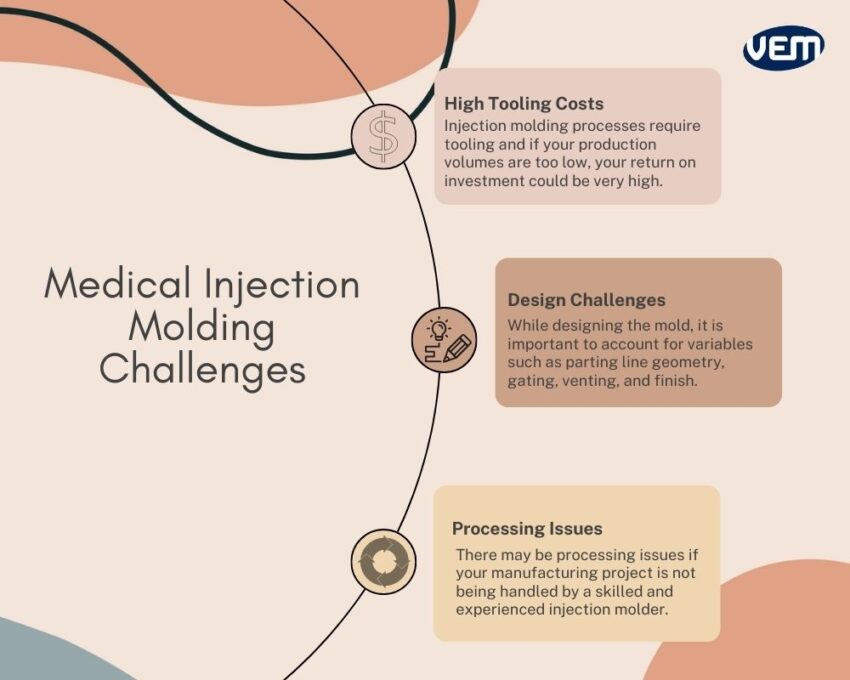
Injection molding processes require tooling and if your production volumes are too low, your return on investment could be very high.
You should note that medical injection molds can be very expensive as they need to be of the highest quality. Even a difference of a few millimeters or microns can render the plastic part non-functional. In addition, medical products require a high degree of precision which is why you will need to invest in a high-quality steel mold.
In addition to high tooling costs, there may be design challenges. While designing the mold, it is important to account for variables such as parting line geometry, gating, venting, and finish.
You should also consider the design of the part itself and note that, when the two halves of the injection mold open, the plastic part needs to eject smoothly. If it does not eject smoothly, your plastic part can be damaged.
There may be processing issues if your manufacturing project is not being handled by a skilled and experienced injection molder. For instance: The tool may not completely fill the mold if the pressure and temperature are not optimally set. It is thus essential to ensure that your project is being implemented by a skilled injection molder.
You should also note that making constant equipment adjustments increases the potential for part quality issues, longer run times, and higher scrap rates.
Medical and healthcare products are imperative to patient safety. It is thus essential to not only ensure the overall product quality but also the manufacturing process of every individual component. Every step, from design to QC of the finished process is crucial in the manufacturing process which is why you should choose an experienced manufacturer that emphasizes quality and complete part traceability.
VEM Tooling offers seamless molding and manufacturing medical injection molding solutions. Our comprehensive manufacturing process allows the customers to maintain oversight over the production of their parts, thus, resulting in greater transparency and accountability. We maintain ISO certifications and cleanrooms that strictly adhere to the specifications and standards of the medical industry. We also provide custom injection molding services at cost-effective prices and detailed reports of inspection and material tests.
To better understand how VEM tooling can provide you with the expertise and serve you for your medical injection molding project, contact us or request a quote today.
Plastics have a wide range of applications in the medical industry. They can be used to manufacture parts and tools such as syringes, surgical gloves, IV tubes, catheters, etc.
Medical-grade plastics are a type of category that is specifically used to manufacture medical products. The primary requirement for medical-grade plastics is that they need to be biologically non-reactive so that they are suitable for manufacturing surgical, vitro diagnostics, and primary packaging products.
While this depends from manufacturer to manufacturer, VEM Tooling offers custom tooling and injection molding services that can build even the most intricate molds within a limited timeframe while maintaining cost efficiency. The production timeline, however, depends upon your specific requirements.